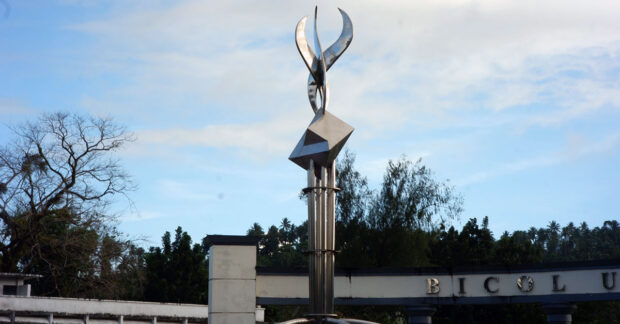
BEACON | Bicol University’s torch sculpture symbolizes the institution’s guiding hand in the students’ learning journey. (Photo by KEZIA SHANE REYES / Inquirer Southern Luzon)
LEGAZPI CITY, Albay, Philippines — Bicol University (BU) is pioneering the implementation of equity policy to give “marginalized and economically disadvantaged” students more access to free higher education.
Under the new policy, the socio-economic profile (SEP) will now account for 15 percent of the overall BU college entrance test (Bucet) rating of student applicants, which will be implemented for the first time by the university this school year, after it was approved by its Board of Regents (BOR) on Feb. 21.
BU president Dr. Baby Boy Benjamin Nebres III, in an interview last week, said the Albay-based institution is the first among the state universities and colleges (SUCs) in the country to implement this policy in response to Commission on Higher Education (Ched) Chair Prospero de Vera’s call for SUCs to reignite the “real essence” of Unified Student Financial Assistance System for Tertiary Education (UniFAST) or the Free Higher Education program.
It was a way “to show that the subsidy is really for the needy,” he said.
READ: Another Bicol University campus to rise in Ligao City
Dr. Hennie Pama-Lomibao, dean of the BU admissions office, said the inclusion of SEP in the admissions process is aimed at providing “good competing chances” for applicants from marginalized sectors.
“The tuition (in BU) is free, so it’s just appropriate that this free tuition will be enjoyed, especially by those students who really need it,” Pama-Lumibao said.
First in 30 years
The implementation of equity policy will be revisited every two years after its implementation to check on its effectiveness. It was approved by the BU BOR in the Feb. 21 meeting in Manila with Ched commissioner Dr. Marita Canapi, who chairs the university’s BOR.
Pama-Lumibao said this was the first time in 30 years that the guidelines for Bucet applicants had been revised: “I think it’s about time. It’s been 30 years or more. It’s about time that we consider quality as a screening metric plus a certain percentage for equity.”
One of the considerations in revising was the “attraction and absorption rates” observed between poor and affluent students of the university.
“If we look at the data of Bucet, the attraction rate of BU towards students from the marginalized sectors is high but their absorption rate is low for the past five years. [On the other hand], the attraction rate from higher, more affluent students in terms of socio-economic background is low but their absorption rate is very high. So, which means there’s a need to balance out. By balance out, I mean increase the chances of less privileged students to compete for the slots,” she explained.
Under the revised Bucet criteria, the examination scores will still be the biggest component with an allocation of 65 percent, followed by the general weighted average from Grades 9 to 11 of the applicants, at 20 percent. The applicants’ SEP, or 15 percent of the rating, will be assessed based on their families’ income classification and marginalization.

